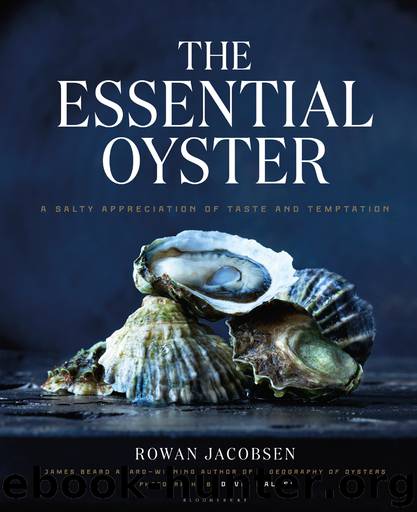The Essential Oyster by Rowan Jacobsen

Author:Rowan Jacobsen
Language: eng
Format: epub
ISBN: 9781632862570
Publisher: Bloomsbury Publishing
Published: 2016-01-20T16:00:00+00:00
PINE ISLAND
WIDOW’S HOLE
GREENPORT HARBOR, PECONIC BAY
SPECIES Eastern
CULTIVATION Two-millimeter seed is raised in upwellers in Widow’s Hole, a small saltwater pool behind the Osinskis’ house, until large enough to be transferred to off-bottom cages on the four-acre grounds just off the edge of their yard. Cages are winched to the surface by small boat.
PRESENCE Flaunts the classic Peconic burnt-orange algal shading over a black-and-white shell. Cups can be deep; shells can be a bit brittle. Generally very juicy inside. Slipper shells often ride along.
FLAVOR Intensely salty and undergirded by iron. Around Christmas, they are sweet as bonbons.
OBTAINABILITY Ubiquitous in Manhattan. The Widowmobile runs about five thousand oysters a week straight to NYC restaurants.
MIKE OSINSKI WAS RETIRED AT FORTY-FOUR. He’d made his millions in finance and had put himself out to pasture in Greenport, New York, savoring sunsets from the porch of his 1830s whaler’s mansion overlooking Greenport Harbor. The Shelter Island Ferry pretty much cuts through his backyard. Then Osinski learned that Greenport was once the oyster powerhouse of Long Island. Huge shucking houses, huge shell piles. Then, as fate would have it, he learned that along with the deed to his house came four acres of prime bottomland. (New York is one of the only states where an individual can own, instead of lease, submerged real estate. But unless people paid the taxes on their bottomland, the state took it over; at Osinski’s mansion, somebody had paid.) Around 2000 he began playing around with oysters, and starting in 2003 he went all in, driving his Widow’s Holes into Manhattan once a week.
Osinski was ahead of the curve. Back when oysters were distributed like canned tuna, the revelation of a briny Widow’s Hole that hadn’t been kicking around a distributor’s walk-in for two weeks was a game changer for many chefs. All the usual players signed on: Esca, Aquagrill, Le Bernardin . . . (Why does Chef Eric Ripert seem to be the first to discover every new oyster? He also gets credit for Island Creeks and Rappahannock Rivers.) A goofy New Yorker profile followed, and suddenly Osinski was the poster child for boutique oyster farming.
What impresses me is that, many years later, Osinski has stuck to his guns. He’s still out on the water every day, his wife and teenage kids beside him. His oysters are still bright and lively, with a bracing freshness. And he’s still a nonconformist. Everything you want in an oyster farmer.
The little critters in the photo clamping onto the Widow’s Holes like limpet mines are slipper shells, aka quarterdecks, aka Crepidula fornicata (don’t ask). Invert these little sea snails and you’ll see they have a kind of shelf over half their shell, hence the common names. Slipper shells abound on the northeastern coast, and they like nothing better than to ride along on the shell of an oyster (or, of course, a slipper shell of the opposite sex). Mike Osinski was the first person to tell me I could eat them live, which I did immediately.
Download
This site does not store any files on its server. We only index and link to content provided by other sites. Please contact the content providers to delete copyright contents if any and email us, we'll remove relevant links or contents immediately.
| Cajun & Creole | California |
| Hawaiian | Mid-Atlantic |
| Midwestern | New England |
| Northwestern | Soul Food |
| Southern | Southwestern |
| Western |
Biscuits: A Savor the South Cookbook by Belinda Ellis(4289)
The French Women Don't Get Fat Cookbook by Mireille Guiliano(3604)
A Jewish Baker's Pastry Secrets: Recipes from a New York Baking Legend for Strudel, Stollen, Danishes, Puff Pastry, and More by George Greenstein(3544)
Better Homes and Gardens New Cookbook by Better Homes & Gardens(3524)
Ottolenghi Simple by Yotam Ottolenghi(3514)
Al Roker's Hassle-Free Holiday Cookbook by Al Roker(3499)
Trullo by Tim Siadatan(3378)
Bake with Anna Olson by Anna Olson(3355)
Hot Thai Kitchen by Pailin Chongchitnant(3320)
Panini by Carlo Middione(3249)
Nigella Bites (Nigella Collection) by Nigella Lawson(3171)
Momofuku by David Chang(3139)
Salt, Fat, Acid, Heat: Mastering the Elements of Good Cooking by Nosrat Samin(3106)
Modern French Pastry: Innovative Techniques, Tools and Design by Cheryl Wakerhauser(3074)
Best of Jane Grigson by Jane Grigson(2944)
Classic by Mary Berry(2941)
Solo Food by Janneke Vreugdenhil(2928)
Tapas Revolution by Omar Allibhoy(2926)
Ottolenghi - The Cookbook by Yotam Ottolenghi(2869)
